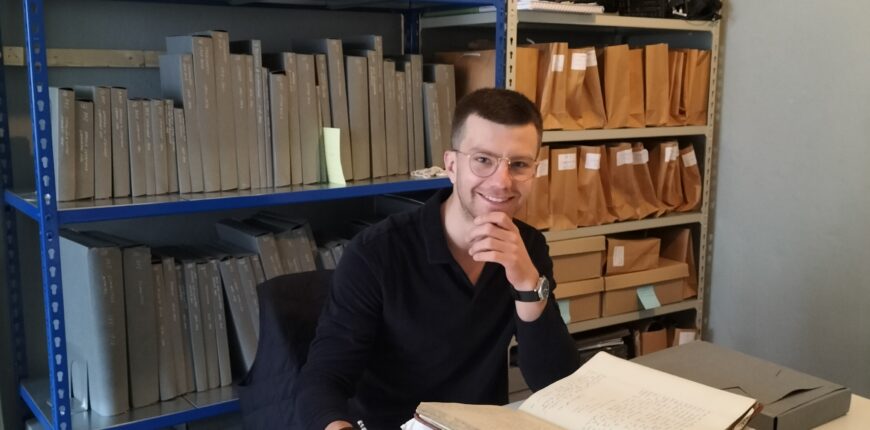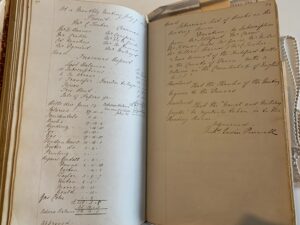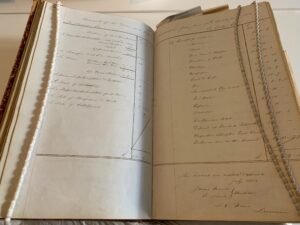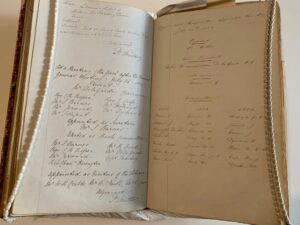Devon and Exeter Institution, Committee Minute Book(s), 1848-1880
DEI Archive reference C/1/2

From January to April 2023, History MA student Jonathan Neuhoff from the University of Exeter joined us for an internship, where he used the Devon and Exeter Institution’s archive to investigate the provenance of a number of artefacts and pieces of furniture in our upstairs reading rooms. For May’s Book of the Month blog he reflects on the DEI Committee Minute Books, which were a crucial source for his research.
Every club or society, no matter if a Premiere League football club or a local model club has to have some sort of central organising and decision-making body. The Devon and Exeter Institution is no exception from that. Its central body, the General Committee, met on a regular basis once per month. If urgent or pressing matters needed to be discussed, additional special meetings could be called in. Similar to other clubs, whatever was discussed in these meetings, was put to protocol and collected in a book, the Committee Minute Book.
From the founding of the Devon and Exeter Institution in 1813 until at least the middle of the twentieth century, these proceedings are structured in a very similar manner and give insight into the day-to-day business of the Institution. Starting with a list of the committee members in attendance, the meetings usually began with the Treasurer’s Report describing the financial situation of the Institution. Then bills that had to be paid were listed. The Book Sub-Committee then presented their suggestions of books to be bought. Afterwards, the Librarian read the list of books in the Reading Room. If books or artworks have been donated to the Institution, a list of these donations was read by the Librarian as well. Any other business, such as complaints, transfers of shares, the admittance of new subscribers, etc. was dealt with after the reports have been read. Additionally, if any Sub-Committees had reports to give, these were read at this point of the meeting. How the minutes of one of these meetings look like can be seen in Figure 1.

Figure 1
The meetings before and after the Annual General Meeting are very interesting. In the last meeting of the year, usually in June, the Treasurer provided a report of all expences as well as revenues the Institution generated in a year (Fig. 2). In the first meeting of the next year, usually held in July, the General Committee elected important positions such as Treasurer, Chairman, as well as the members of the several Sub-Committees (Fig. 3). It is interesting to see, what a long-lasting impact some people had on the Institution. Some Librarians worked for several decades with the Institution and some of the Committee members also shaped the Institution for several years.

Figure 2

Figure 3
By their very nature the Minutes provide us with a window into the history of the Devon and Exeter Institution. Periods during which the Institution went through difficulties are presented from an inside perspective. Solutions to problems as well as the discussions around these problems can be traced in the Committee Minutes.
Yet apart from the history of the Institution itself we can learn about the history of the city of Exeter and about the society of the nineteenth century. As the museum collection of the Devon and Exeter Institution became too large for example, members of the Institution played a fundamental part in the establishment of the Royal Albert Memorial Museum (RAMM) in the 1860s. Nowadays, the RAMM is one of the most important tourist attractions in Exeter. Additionally, the Minutes give insight into the technological progress made in the nineteenth century and societies’ reaction to it. When the Institution installed gas lights in the 1850s, people were at first sceptical about the new technology but grew accustomed to it quickly. Something similar happened in the early twentieth century with the installation of electricity in the Institution. The changing society can also be observed in the Minutes. Whereas women were practically not mentioned until the third quarter of the nineteenth century, they became more and more visible in the late nineteenth/early twentieth century, even becoming members of the General Committee.
Because the Committee Minutes give inside into the history of the Institution as well as provide a window into the past, they are a very valuable and unique source.
Jonathan Neuhoff, April 2023

